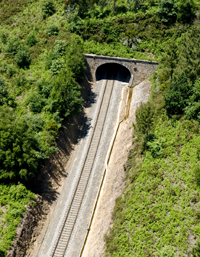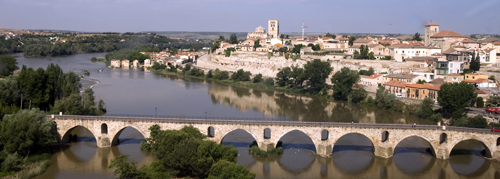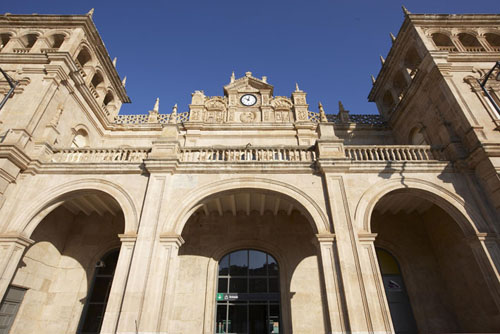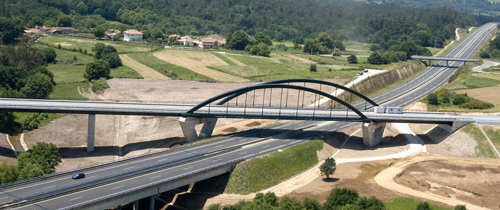Madrid - Galicia line
Actions carried out on the line

The routes of Galician railways have always been influenced by the rugged relief that has hindered railway communications with the centre of Spain.
The new access to Galicia starts at the junction of the Madrid -Valladolid line in Olmedo and ends in Santiago de Compostela, where it links with the Galician Atlantic Rail Corridor.This new route is 434.86 km long.
This high-speed section, part of the Madrid - Galicia high-speed line, leaves the Madrid - Segovia - Valladolid high-speed line at Olmedo.It is 99 km long, standard or UIC gauge (1,435 mm) and it has been designed for speeds up to 350 km/h.The electrification is 2x25 kV 50 Hz alternating current, with ERTMS and Asfa traffic control systems, and a GSM-R mobile communications' system.

The route includes 15 viaducts, two pergolas, two sidings in Medina and Toro (Zamora), a new station in Medina del Campo, and the adaptation of the existing station in Zamora.
The exceptional points along the route include the viaducts over the Trabancos River (874 m), the Pitanza Stream (820 m) and the Douro River (620 m).
Zamora – Lubián is the longest section on the line. It runs from the centre to the far northwest corner of the province of Zamora on a route that is to the east and independent of the conventional Zamora - A Coruña line.After crossing the Ricobayo reservoir, it runs through plains alongside the Culebra Mountains.The terrain becomes abrupt again around Puebla de Sanabria. Here, since the route runs halfway up the hillsides, small tunnels will have to be built as far as the Portilla Padornelo pass, which leads to the Lubián Valley bordering with Galicia.
Adaptation of Zamora Station:

The works undertaken by Adif Alta Velocidad (Adif High Speed) on Zamora Station included works on the bed for 2,880 m of double track in the area of the station itself, and a complete reorganisation of the line layout, with the high-speed tracks side by side with those corresponding to standard gauge on the Medina - Zamora - A Coruña line.
Three platforms were built with underground crossings and canopy roofs, a maintenance shed and a new conventional network electronic interlocking, as well as the installation of lifts, information systems and lighting.
The incorporation of the city of Zamora into the high-speed network also includes works corresponding to the adaptation and remodelling of the station building.
This section is where the line enters Galicia.It cuts across the province of Ourense, from the boundary with Zamora in the southeast, on a route that passes through the town of A Gudiña and runs to the north of the A-52 motorway to the provincial capital.
In orographic and geotechnical terms, it is the most complex section of the entire line.For this reason, instead of the whole section being a double-track railway, it was initially planned to use the current single-track Padornelo tunnel.Subsequently, the Ministry of Transport, Mobility and Urban Agenda amended the initial projects with the building of a new Padornelo tunnel, which runs to the right towards Galicia, leaving the current tunnel for the other track.
The difficult terrain and the requirement to comply with high-speed parameters, forces much of the route to run through tunnels to the final destination: Ourense-Empalme Station.This station will be required to serve as a strategic high-speed hub, since it will be the starting and finishing point not only of the section to Santiago, but also of the sections to Lugo, and to Pontevedra and Vigo, which are essential for extending high-speed services in Galicia.
The fourth section of the line was the first to be put into service, on 10 December 2011. The service was subsequently extended to A Coruña, after Adif had completed the electrification of the Santiago - A Coruña section.

Track-bed construction work began in 2004. The route passes through the provinces of Ourense, Pontevedra and A Coruña, running northwest following the A-53 motorway corridor, to link up with the Atlantic Corridor near Santiago de Compostela.
Together with the previous section, this is the most complicated part of the whole route.In order to cross the area’s difficult terrain and to reduce environmental impact, it has been necessary to build a total of 38 viaducts and 31 tunnels, which constitute over 57% of the total length of the section.
It shortens the current distance of the conventional line between Santiago and Ourense by 38.9 km.
A very important aspect of this section is the respect for the environmentally valuable areas through which it passes. Measures have been taken to protect and recover this natural heritage, accounting for over 33% of the budget for the works in some areas.
This section belongs to the Atlantic Corridor, which runs 238 km from north to south along the Atlantic coast, between Ferrol and Portugal.
The previously existing line has been subject to comprehensive improvements, with the doubling of tracks, new routes and the electrification of the route between these two cities. 37,4% of the section is made up of special structures, specifically 17 tunnels (20.2 km) and 10 viaducts (2.8 km).
The new connection between Ourense, Santiago and A Coruña opened on 10 December 2011.

